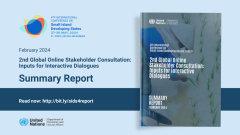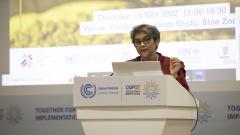- عربي
- 中文
- English
- Français
- Русский
- Español
Building a new understanding of vulnerability for developing countries
The COVID-19 pandemic exposed how all countries are vulnerable to some degree or another. But also how the extent of that vulnerability, and the capacity of different countries to overcome it, varied drastically.
Aside from pushing vulnerability to the forefront of the global consciousness, the economic fall-out of the pandemic also reinforced the urgent need to understand and measure it – so that responses and policies could be rolled out more effectively and equitably when future shocks inevitably strike.
A High-Level Panel was convened by the President of the General Assembly of the United Nations in 2022 to develop a Multidimensional Vulnerability Index (MVI). It is intended that the MVI, using a data-driven approach to define what it means to be vulnerable, will support an evidence-based approach to development policy and decision making, especially in the context of increasingly scarce external financing resources.
The report of the panel – released today – proposes an index built by comparing countries’ vulnerability to external shocks to their resilience to those shocks. Where vulnerability factors can increase the risk of shocks, resilience factors can reduce their impact.
The index looks at vulnerability and resilience from three different dimensions; environmental, economic, and social, recognizing the important interplay between them. The economic dimension includes factors such as financial or trade shocks. The environmental dimension measures aspects like natural hazards and climate change. The social dimension involves indicators of external social shocks, such as pandemics or displaced people.
The most vulnerable countries often find themselves on the frontline of not just single but multiple crises, including climate change and the vagaries of international markets and trade.
Small Island Developing States (SIDS) have been leading calls for a better measurement of vulnerability for three decades. Their structural characteristics, including their small size, remoteness, low productive capacities and inadequate infrastructure, mean they are both highly exposed to shocks and unable to adequately overcome them. For example, when the COVID-19 pandemic hit, many SIDS had not yet recovered from the global financial crisis of 2008-2009. This is the essence of what it means to be vulnerable.
Although generally the most vulnerable countries also suffer low-income levels, many, especially SIDS, do not. These countries may not be the poorest nations when their Gross National Income (GNI) is measured per capita, but they are both more prone to disasters and the costs of their responses are much greater. They rely on external financing to prepare and recover from disasters, but accessing concessional financing is limited because their relative income makes them ineligible for the cheaper finance set aside for lower income countries.
This new index has been shared with all Member States of the United Nations for their inputs and a consultative process will result in the publication of a final index by the end of the year. This index, it is hoped, will form the basis of a new approach to understanding vulnerability – and helping developing countries, their development partners and international financial institutions make more data-informed decisions when deciding how to enhance development cooperation funding.






